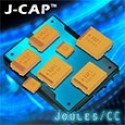source: AVX news
FOUNTAIN INN, S.C. (November 7, 2016) – AVX Corporation, a leading manufacturer and supplier of passive components and interconnect solutions, has extended its J-CAP™ Series conductive polymer capacitors with conductive polymer electrodes, which already delivered the highest energy per volume (Joules/cc) of any SMT capacitor available on the market, with the addition of a new case size and several improved energy ratings.
Now available in a large 7361-15 case with a low 1.5mm height profile, and capable of delivering up to an industry-leading 38.8mJ in low-profile SMD designs, J-CAP Series capacitors each feature a conductive polymer electrode that exhibits a benign failure mode under recommended use conditions, and undertab terminations that enable high both volumetric efficiency in small, low-profile case sizes and close positioning for efficient, high-density PCB layouts. These attributes, combined with the series’ high energy, low ESR (50–300mΩ at 100kHz), and low DCL (0.1CV), allow J-CAP capacitors to deliver compact and cost effective high-energy solutions ideal for backup power applications in demanding solid-state drives (SSDs)— including multilevel cells (MLCs), single-level cells (SLCs), enterprise flash drives (EFDs), and PCI Express (PCIe) drives — in addition to battery-powered portable equipment, industrial alarms, smart power meters, and other mobile devices.
“Released in response to SSD designers’ footprint concerns and high energy requirements, especially for small form factor SSDs, the J-CAP Series’ new 7361-15 case size provides a low profile (1.5mm) alternative to its 7361-20 case, which features the same maximal footprint, and the new energy ratings,” said Allen Mayar, product marketing manager at AVX. “Additionally, the energy rating of the J-Cap series now extends up to 38.8mJ, further improving the superlative volumetric efficiency for which the series is highly regarded.”
Now available in five case sizes with newly extended maximum energy ratings — EIA Metric 3528-10 (AVX “L” case, max 4.7mJ), 3528-12 (“T,” max 4.7mJ), 7343-15 (“X,” max 18.2mJ), 7361-15 (“3,” max 19.6mJ), and 7361-20 (“4,” max 38.8mJ) — J-CAP Series conductive polymer solid electrolytic capacitors currently feature capacitance values spanning 4.7µF to 1,500µF with a ±20% capacitance tolerance. Rated for operating temperatures spanning -55°C to +105°C, and 3x reflow compatible at 260°C, the series is also currently available with four voltage ratings: 6.3V, 16V, 25V, and 35V. Typical derating is 10% for ≤16V and 20% for 20V and higher voltages.
RoHS compliant and lead-free compatible, J-CAP Series capacitors are supplied with pure tin-plated terminations, and are shipped on 7” reels. Lead-time for the series is 12 weeks.






























